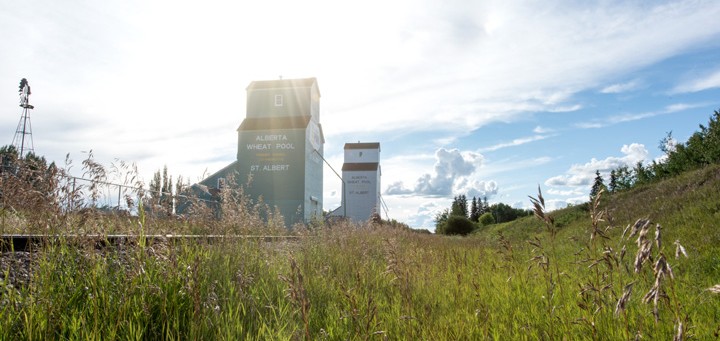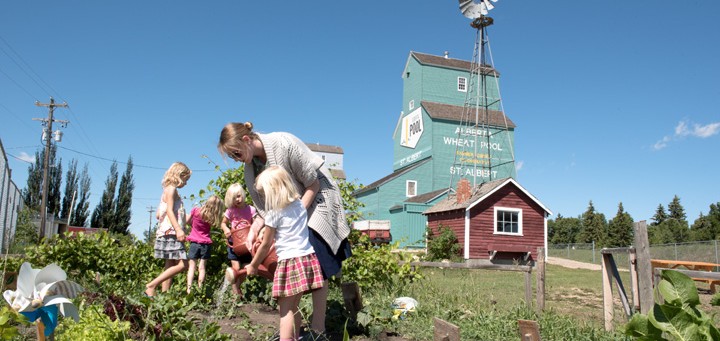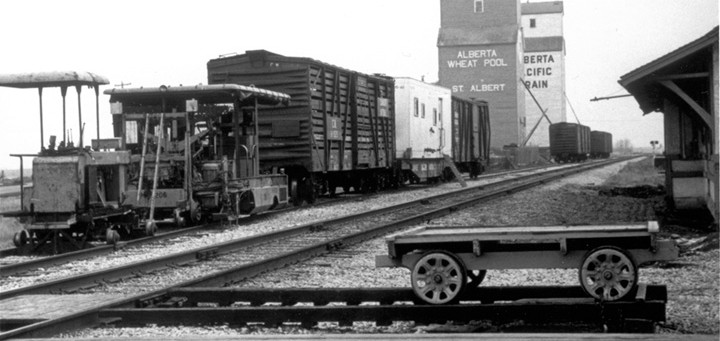Meet You There
harvest moon: ST. ALBERT GRAIN ELEVATORS
December, 2015
The St. Albert grain elevators are an easily recognized landmark dotting the skyline in Mission—the city’s oldest, most historic neighbourhood. Once an essential part of the country’s grain trade, moving the commodity from farm to market, most of the elevators in western Canada have long since been shut down and dismantled. Fortunately, St. Albert has worked to preserve and maintain its prairie sentinels since they ceased operating in 1989, and our two elevators are recognized as some of the best preserved in the province.
Today, our grain elevators serve as a historical museum and educational link to the history of the area, moving St. Albert from Metis settlement to farm village to railway town. Take a look.
1900s
Arrival of the Railway
The early days of St. Albert involved farmers doing commerce with horse and cart. But that changed with the 1906 arrival of the railway, which heralded the development of St. Albert as an agricultural centre and created a link to the outside world.
St. Albert was on the Canadian National Railway (CNR) line, and the grain elevators were built out of necessity in 1906 and 1929, respectively, as the golden age of the grain trade got underway. No longer would farmers have to shovel their grain into two-bushel sacks, bring them to a loading platform along the rail line and empty the grain into boxcars. Elevators now offered a more efficient way to move grain.
St. Albert’s first elevator was built by the B.C.-based Brackman Ker Milling Co. in 1906. In 1929, the Alberta Wheat Pool No. 1 elevator was added; it was a 35,000–bushel standard elevator of the wheat pools -smallest, cheapest design. The building was powered by electricity, as were others in the district (Morinville, Vimy), and the siding painted in trademark red.
1930s, 40s, 50s
Industrialization & the March of Progress
The first grain products addressed the need for horse feed and farm staples, but a growing demand for wheat, oats and barley to larger markets meant farmers needed a fast-moving way to weigh, grade and exchange payment. The agent (who managed business at the elevators and lived at what became 69 -Mission Ave.) was a key player in moving grain from farmer to railcar, via the gravity-based, over/under pocket bin system of the grain elevator.
In coming decades, mechanization of family farm operations, the growth in mixed farming (hogs, dairy) and wildly fluctuating grain production and prices played a role in the industry, as did methods of hauling grain.
1960s, 70s, 80s
The End of an Era
The closing of the railway station at St. Albert in 1965 was a blow to what had once been the heart of the community. After the platform closed, the station house and eventually all CNR buildings were removed, leaving only the grain elevators.
In the 1970s and 80s, there was a dramatic increase of on-farm capacity for grain storage. Semi-trailers could now haul 1,000 bushels of grain (oats, barley, spring wheat, canola), and it became obvious that the old, wooden country elevators couldn’t hold enough grain to be profitable anymore.
“Better roads and bigger trucks made the elevators obsolete,” said Shari Strachan, director of the St. Albert Musée Héritage Museum.
1990s & 2000s
Restoration
After closing for business in 1989, the St. Albert grain elevators were slated for demolition, but community and provincial support saved them from that fate.
They received designation as a provincial historic resource in 1992 and were com-pletely restored by 2011.
The year-long restoration project, which began in 2010, included repair and stabilization of foundations, roof re—shingling and repainting.
Now
Today, the St. Albert Grain Elevator Park is open to the public and school groups for special occasion photos and public events. Knowledgeable interpreters bring the park to life, playing horseshoes, skipping rope, watering the garden with visiting children and making the visit special for the entire family.
“It’s a link to our past,” says the director of the St. Albert Musée Héritage Museum. “People utilize it and recognize the importance of the elevators to our community’s history.” Treat yourself to a visit, and be part of it. t8n
Did You Know?
Grain elevators were designed to get grain into railway cars as quickly as possible. The wooden framed, vertical warehouses used good old gravity to empty the grain and a mechanism known as the leg (an endless belt with cups or scoops attached) to load grain.
Caption:
St. Albert grain elevators and train station, 1971.
Sidebar:
Fun Facts
Back in the day, painting the grain elevators was sometimes a summer job for a student, who was lowered by ropes or (if lucky) used a cherry picker to access it. The maintenance schedule today involves a visual inspection of the exterior every year and a repainting once every seven years.
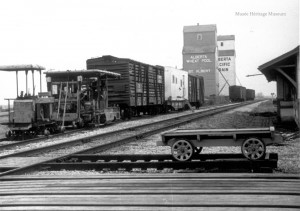
Harvesting Akins’ farm, 1942.
Image credit: Musée Heritage Museum,
St. Albert Historical Society fonds, 2003.01.1543
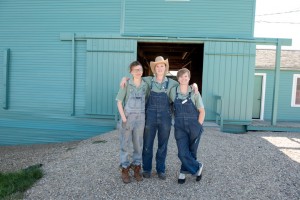 Park interpreters in front of the 1929 elevator.
Park interpreters in front of the 1929 elevator.


